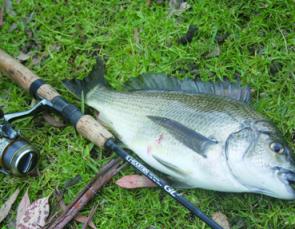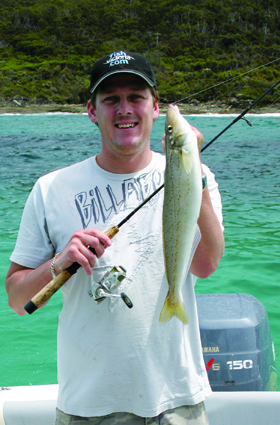Situated on the very popular Great Ocean Road, only 140km southwest of Melbourne and set between the clear waters of Loutit Bay and the ancient forests of the Otway National Park, Lorne has all the charm that a coastal resort town can offer. With a large variety of trendy cafés, restaurants, boutique shops, waterfalls, long sandy beaches and other amazing natural wonders, it’s easy to see why this is such a popular holiday location – but there’s also great fishing!
At first the town mightn’t strike you as a fishing destination, because Lorne has a reputation as a major party town. For starters, hundreds of year 12 school leavers swarm through the town for ‘Schoolies Week’ each November, to celebrate their new-found freedom. It's not just the kids that get to have fun, either. Lorne is home to the world’s largest open water swim each January, The Pier to Pub, plus one of Australia's biggest New Years Eve parties, The Falls Festival.
If you are heading down to Lorne this New Year, make sure you pack the rods because this place has plenty to offer besides loud music and spectacular views. The town is home to some excellent offshore fishing, a productive river estuary, beautiful trout streams and one of the best piers along the coast. With a large range of species on offer including squid, flathead, barracouta, bream, mullet, brown trout, silver trevally, snapper, warehou, King George whiting, garfish, Australian salmon and many species of shark, you may have trouble working out where to start! Here are a few tips.
The freshwater reaches of the Erskine River hold a good population of brown trout, and while the fish aren't big, they are aggressive and great sport on light tackle. I like to flyfish with small weighted nymphs under an indicator, or, if it’s a fine day with no wind, I will cast a dry fly such as a Royal Wulff or Red Tag. The key to catching fish is making sure your flies get a drag free drift and are not pulled through the water unnaturally. Shallow running hard-bodied lures also work a treat in the Erskine, especially around the Great Ocean Road bridge. Brands such as Rebel, Rapala and RMG are popular. Fishing with worms along the caravan park banks will occasionally take trout as well.
Just to the south of Lorne is the St George River, and another 9km further south along the Great Ocean Road is the picturesque Cumberland River. Both these are great little trout streams. As with the Erskine, all styles of fishing will work in these rivers, although drifting small nymph flies down with the current in the Cumberland is absolutely deadly. Access to all rivers in the area is as easy as finding a park where the rivers cross the Great Ocean Road, then walking along the banks. Sometimes it’s easier to get in the water and wade up the river, so take a pair of thigh waders to stay dry, or old sandshoes if you don’t mind getting wet feet.
The Erskine River estuary runs right through the town of Lorne and is a fantastic place to wet a line. The estuary system is full of bream and mullet, and even the occasional estuary perch is landed from time to time. Bream, the main target for most fishers, can be seen cruising on the sand flats from the old swing bridge down at the mouth of the river, or hiding amongst the snags up around the Great Ocean Road bridge.
I have learnt over the years that just because you can see the bream, it doesn't mean they are easy to catch. In fact it is usually quite the opposite. When the water is clear and low, the bream are very flighty and prove a real challenge. If, on the other hand, the water is slightly discoloured on an overcast day, you might not see any fish cruising but chances are your catch rate will be better.
There is an enormous amount of very small bream in this estuary and they can become a real pain, stealing bait after bait – but don't be put off, as there are some true monsters in the system as well. A good option to get away from the pickers is to use a lure. Both soft plastics and hard-bodied lures work, but in different sections of the estuary. Up in the snags a small hard-bodied Ecogear lure is deadly, while down on the sand flats a soft plastic Berkley 6" Sandworm slowly twitched along the bottom is irresistible to hungry bream. Of course other lures will work as well, but these are a good starting point.
The main species targeted by boat fishers out from Lorne are gummy and school sharks, flathead, snapper and King George whiting. The best time of year to chase these species is during the warmer months from November through to April.
Anglers fishing for King George whiting and flathead normally travel north from the pier and fish in close around the many small reef systems for the whiting, or out wide in 30m or more for flathead. When chasing snapper or gummy sharks, head south and fish out wide from Mount Defiance. Here you will find broken ground, which gives these species somewhere to hang out during the day and hunt food. Use heavy sinkers of about 8–12oz, and a sea anchor to slow your drift if it is windy.
If you land a gummy shark or snapper, mark the location on the GPS and keep concentrating your efforts in that same area, as other fish will be nearby. Use fresh baits such as fillets of flathead or barracouta, or, if possible, catch some squid from the pier and use the heads for bait the same day.
There are two boat ramps situated either side of the pier, one of which belongs to the Lorne Aquatic Club and is only useable at high tide. The other is a beach launch situated behind the Fishermans Co-operative and is best suited to lighter aluminum boats and owners of 4WD vehicles.
You can’t go to Lorne without fishing on the pier! It is very well know as a fantastic land-based fishing location for species such as trevally, barracouta, snapper and squid, just to name a few. Night fishing is very popular and the pier is well lit, making it easy to see what you are doing. Fishing after dark is the prime time for gummy sharks, snapper, barracouta and occasionally garfish. When wetting a line during the day, silver trevally, warehou and Australian salmon are commonly caught – but be prepared for just about anything.
There are some great rock platforms around Lorne from which King George whiting, snapper and Australian salmon can be targeted. Long 12’ surf rods with a single hook paternoster rig and a bomb sinker will help avoid getting snagged, or, worse still, losing your fish in the rocks. Try the rocks just to the north of Lorne, as these drop straight onto a deep sandy bottom and often produce good numbers of fish. Remember to take extreme care when rock fishing and keep an eye on the ocean at all times. The beach at Lorne is also worth a try during the winter when the salmon are running. Fish towards the northern end of the beach as the water tends to be deeper here and you won’t have problems with swimmers and surfers getting in the way.
So, if you find yourself heading to Lorne for a New Year’s Eve party, don’t forget to pack your fishing gear, and even your boat. The region offers fishing for wide range of species, and summer is a great time to target them.
Facts
1
TACKLE AND ACCOMMODATION
Lorne lacks a dedicated fishing shop, but the hardware store sells a limited supply of bait and tackle, which will get you out of trouble if you run out of hooks and sinkers. Lorne also offers a variety of accommodation, ranging from five star resorts and hotel accommodation in the heart of the township, to apartments, motels, guesthouses, cottages, caravan parks, bed and breakfasts and holiday home rentals. Regardless of your budget, you're sure to find something that suits and if you have a good look around you will realize that it doesn’t have to cost an arm and a leg to stay in Lorne. (If the ‘Schoolies’ can do it, anyone can!). A few places to try are:
Cumberland Resort, 03 5289 2400
Lorne Real Estate, 03 5289 4222
Lorneview Apartments, 03 5289 1199
Mantra Erskine Beach Resort, 03 5289 1209
Facts
2
GEAR TO BRING
Freshwater: If you’re into flyfishing then bring a light fly outfit in 3–6 weight, and an assortment of both dry flies and nymphs. Bait and lure fishermen will do best with a light 6’ spin rod and a reel matched with 2–3kg line. Don’t forget the waders or you will end up with wet feet, socks and pants.
Estuary: Light spin rods in 6–7’ are ideal for lure casting and bait fishing. Bring a large assortment of lures including both hard bodied and soft plastics or hooks in size 4 -6 if you intend on bait fishing.
Land-based: Surf rods are handy for lifting fish when wetting a line from the pier, but can be a bit clumsy when it is crowded. Smaller rods can be used with good success, although a drop net is needed to land heavy fish. Don’t forget the squid jig!
Surf rods of 12’ are a must when fishing from the rocks or the beach, as they help with casting long distances and to keep the line up out of the waves. Line of 10–15kg and a 3oz sinker will get you out amongst the fish, while allowing you to also lift heavy fish on to the rocks.
Boat: Big overhead reels capable of holding 300m of 15kg monofilament line and heavy 6’ rods work best from the boat when fishing for gummy sharks and snapper. Remember to bring plenty of spare 4/0 hooks and 8oz sinkers, as the barracouta will constantly bite you off when they are around. Lighter 6’ rods of 3–4kg are the go when chasing King George whiting from the boat. I use a running sinker rig and size 4 baitholder hooks.

If you own a 4WD vehicle, light aluminum boats can be launched off the beach next to the pier.

Large snapper can be caught off Lorne from October to March each year. Dean Candy took this thumper from his boat, but others are caught from the rocks and pier during these months as well.

An Erskine River bream that fell to a small soft plastic lure. There are stacks of small bream in the Erskine estuary, but for persistent anglers there are some thumpers as well.

Gummies of this size are common off Lorne, with some real monsters swimming around out there as well.

The rocks just north of Lorne are a great land-based option in the summer months.

Always worth a visit: the Lorne pier is a very popular and productive fishing location at any time of the year.

Big whiting are the reward for boat anglers fishing offshore from Lorne.




